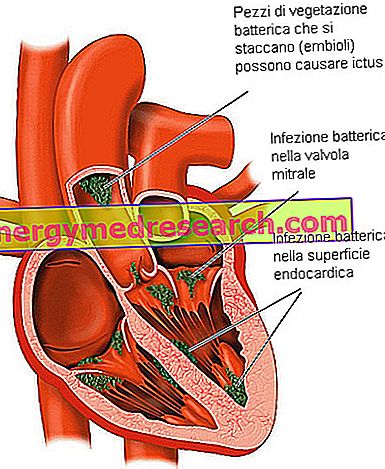What is ittero?
Jaundice refers to the yellowish and uniform coloration that the skin, sclerae and other tissues take in response to a pathological increase in the blood values of bilirubin, with consequent accumulation of the substance locally.
Similar symptoms, but less obvious and mostly localized to the frenulum of the tongue and to the ocular scleras, are also found in the presence of sub-jaundice (considered the antechamber of the true jaundice).
In most cases, jaundice depends on liver or gallbladder disease.

Causes of Yellow Skin
To learn more: Yellow Leather
Beyond jaundice, the skin can take on a yellowish complexion in various conditions, such as carotenosis or the accumulation of skin of urochrome or of colors absorbed through the skin; in these cases - called pseudo-arteries - the chromatic alterations are distinguished from those typical of jaundice due to the lower uniformity and to the saving of the ocular sclerae and mucous membranes.
Jaundice appears when the bilirubin circulating in the blood (bilirubinemia) exceeds 2-2.5 mg per 100 ml, while there is sub-jaundice when these values exceed the abnormality (1.5-2 mg / dl) without reaching this threshold; this makes it possible to direct the patient towards an early diagnosis and thus undertake an adequate therapy to prevent its evolution.
Types of Icterus
The classification of jaundice can be made on the basis of different elements. In relation to the serum concentration of bilirubin, for example, jaundice can be mild, medium or severe, while depending on the shades of skin it is called flavinic, rubinic, greenish and melanic jaundice.
Causes
What is Bilirubin?
To understand the pathogenesis of jaundice it is necessary to know the metabolism of bilirubin, widely illustrated in the following article. Briefly, we recall how this pigment deriving from the catabolism of aged red blood cells, is made water-soluble by the liver, which transforms it into direct bilirubin to facilitate urinary elimination. Once the jaundice is recognized, it is therefore necessary to establish whether it is due to the excess of direct bilirubin (conjugated with glucoronic acid) or indirect (not yet processed by the liver); the orientation towards one or the other diagnosis, confirmed only by blood tests, can be based in the first instance on the physical examination of the urine: if these appear dark it means that the conjugated bilirubin is regularly eliminated, while the absence of the typical straw reflections leads us to think that something in the liver is not working properly. Similarly, it is worth remembering that the typical coloration of the stools is due to the chemical conversion of bilirubin into urobilin and stercobilin by intestinal bacteria and enteric enzymes.
Types of Icterus
Obstructive Jaundice
The premises of the previous chapter are particularly useful in examining obstructive jaundice, a condition in which the urine accentuates its color, while the stools appear clear.
From what has been said, it is evident that in similar situations the liver is able to perform its function (only the conjugated bilirubin is eliminated by the kidney), but that the outflow of bile towards the intestine is prevented.
This impediment can be caused by:
- from the obstruction of the bile ducts (for example due to the presence of stones or sclerosing cholangitis)
- or from liver diseases of various origins (hepatitis, cirrhosis of the liver) that hinder the excretion of bile from the liver (we can therefore have intra or extrahepatic obstructions).
Since the bile cannot leave the liver we will have dark urine and pale stools.
The obstructive jaundice, which is characterized by an increase in direct bilirubin levels in the blood, allows us to make a further reference to human physiology; we remember in fact how bile is essential for the digestion of fats, which is why in the presence of an obstructive jaundice the faeces, in addition to appearing clear, are rich in fat (steatorrhea). The symptomatology is completed by bradycardia and itching, due to the presence of circulating bile salts.
Hepatocellular jaundice
Hepatocellular jaundice is linked to reduced liver cell function; as such, it is characterized by increased levels of indirect bilirubin in the bloodstream and can be caused by:
- inability to capture the indirect bilirubin due to anatomical or functional deficiency of two proteins, the Y and Z ligandins, which hold it in the hepatocyte freeing it from albumin (to which it is associated in the bloodstream); is the case with Gilbert's syndrome.
- Inability to conjugate indirect bilirubin : for example in neonatal jaundice (physiological condition typical especially of premature babies) or as a side effect of some drugs.
- Congenital defect of the enzyme glycuronyltransferase (implicated in the salification of indirect bilirubin with glycuronic acid): Crigler-Najjar syndrome.
Hemolytic jaundice
In hemolytic and in the hyperproduction jaundice of bilirubin, urine and faeces they maintain their coloring, which is often accentuated.
This condition is linked to the massive destruction of red blood cells (as in the presence of hemolytic anemia, a disease that can be caused by:
- bacterial infections,
- autoimmune or genetic diseases such as favism;
- hyperfunction of the spleen)
- an ineffective erythropoiesis (pernicious anemia, thalassemia, leukemia, etc.)
- from increased production of bilirubin (in the liver or bone marrow).
In such conditions, the liver increases the metabolism of unconjugated bilirubin (with hyperpigmentazine of urine and faeces) but this is not enough to prevent its increase in circulation; there is therefore an jaundice with indirect hyperbilirubinemia.
Special Types of Jaundice
- Jaundice in pregnancy
- Jaundice of the newborn
Treatment
The treatment of jaundice is subject to the causes of onset; in this regard we refer to the reading of specific articles:
- Drugs for the treatment of ittero
- Medicines for the treatment of gall bladder stones
- Drugs for the treatment of liver cirrhosis



